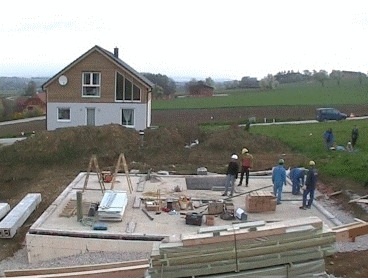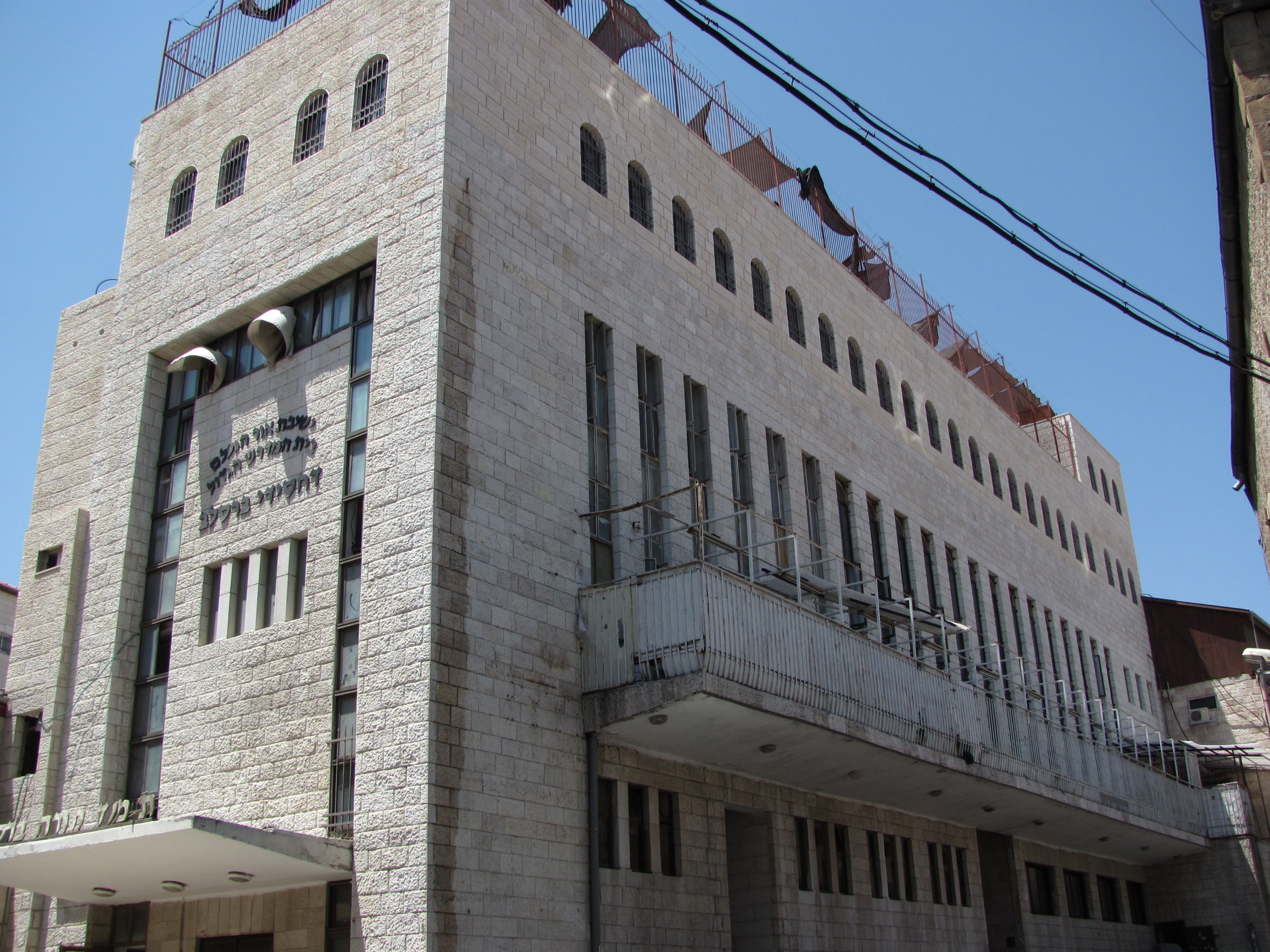|
Ramot Polin
Ramot Polin (, ''lit.'' Poland Heights) is a neighborhood in the Israeli settlement of Ramot in northwest East Jerusalem consisting of a single housing complex. It was constructed by the Kollel Polen (Poland) in stages beginning in 1972, under the auspices of the Office for Building and Habitation, and is populated, as intended, mostly by Haredi Jewish families, including Breslov. The neighborhood contains 720 housing units of varying sizes. Planning and building The background to building this neighborhood, as well as several other neighborhoods in Jerusalem - including additional sub-neighborhoods in Ramot and in Gilo, was to settle wide parts of Jerusalem through new building after the 1967 Six-Day War The Six-Day War, also known as the June War, 1967 Arab–Israeli War or Third Arab–Israeli War, was fought between Israel and a coalition of Arab world, Arab states, primarily United Arab Republic, Egypt, Syria, and Jordan from 5 to 10June .... This phenomenon was ... [...More Info...] [...Related Items...] OR: [Wikipedia] [Google] [Baidu] [Amazon] |
Zvi Hecker
Zvi Hecker (; 31 May 1931 – 24 September 2023) was a Polish-born Israeli architect. His work is known for its emphasis on geometry and asymmetry. Biography Zvi Hecker was born as Tadeusz Hecker in Kraków, Poland. He grew up in Poland and Samarkand. He began his education in architecture at the Cracow University of Technology. He immigrated to Israel in 1950."Zvi Hecker" Arcspace. Date: 7 March 2001, retrieved 24 October 2007. There he studied architecture at the Technion - Israel Institute of Technology, graduating in 1955. At the Technion, Arieh Sharon#Private practice, Eldar Sharon was a classmate, and Alfred Neumann (architect), Alfred Neumann was their professor. Between 1955 and 1957, he studied painting at the Avni Institute of Art and Design, before beginning his career as an architect. Between 1957 and ... [...More Info...] [...Related Items...] OR: [Wikipedia] [Google] [Baidu] [Amazon] |
Visionary Environments
{{Short description, Type of artistic installation A visionary environment or fantasy world is a large Installation art, artistic installation, often on the scale of a building or sculpture parks, intended to express a vision of its creator. The subjective and personal nature of these projects often implies a marginal status for the artists involved, and there is a strong association between visionary environments and outsider art. List of visionary environments * Jim Bishop: Bishop Castle (US) * Aw Boon Haw (胡文虎) (sponsor/concept): Haw Par Villa (Singapore), Tiger Balm Garden (Hong Kong), Tiger Balm Garden (Hong Kong) * :de:Johann Michael Bossard, Johann Michael Bossard: Kunststätte Bossard (Germany) * Peter Camani: Midlothian Castle (Peter Camani#Screaming Heads, Screaming Heads) (Canada) * Ferdinand Cheval: Le Palais idéal (France) * Jean Cocteau: Chapelle Saint-Pierre à Villefranche-sur-Mer, Chapelle Sainte-Blaise des Simples de Milly-la-Forêt (France) * María Ánge ... [...More Info...] [...Related Items...] OR: [Wikipedia] [Google] [Baidu] [Amazon] |
Zvi Hecker Buildings
Zvi ( and , ''Tzvi'', Ṣvi, "gazelle") is a Jewish masculine given name. It is sometimes paired with Hirsch, the German and Yiddish word for "deer", in a bilingual pleonasm. Notable people with this name include: * Zvi Aharoni (1921–2012), Israeli Mossad agent * Zvi Arad (1942–2018), Israeli mathematician, acting president of Bar-Ilan University, president of Netanya Academic College * Zvi Hirsch Gregor Belkovsky (1865–1948), jurist, economist, and Zionist activist * Zvi Ben-Avraham (born 1941), Israeli geophysicist * Zvi Bern (born 1960), American physicist * Zvi Bodie (born 1943), American academic * Zvi Bornstein (1926–2024), Slovak antifascist fighter * Zvi Hirsch Chajes (1805–1855), Orthodox Polish rabbi * Zvi Chalamish, Israeli financier * Zvi Elpeleg (1926–2015), Israeli academic * Zvi Galil (born 1947), Israeli computer scientist, mathematician, and President of Tel Aviv University * Zvika Greengold (born 1952), Israeli officer during the Yom Kippur War, a ... [...More Info...] [...Related Items...] OR: [Wikipedia] [Google] [Baidu] [Amazon] |
Israeli Settlements In East Jerusalem
Israeli may refer to: * Something of, from, or related to the State of Israel * Israelis, citizens or permanent residents of the State of Israel * Modern Hebrew, a language * ''Israeli'' (newspaper), published from 2006 to 2008 * Guni Israeli (born 1984), Israeli basketball player See also * Israel (other) * Israelites (other), the ancient people of the Land of Israel * List of Israelis Israelis ( ''Yiśraʾelim'') are the citizens or permanent residents of the State of Israel. The largest ethnic groups in Israel are Israeli Jews, Jews (75%), followed by Arab-Israelis, Palestinians and Arabs (20%) and other minorities (5%). _ ... {{disambiguation Language and nationality disambiguation pages ... [...More Info...] [...Related Items...] OR: [Wikipedia] [Google] [Baidu] [Amazon] |
Haredi Judaism In Jerusalem
Haredi Judaism (, ) is a branch of Orthodox Judaism that is characterized by its strict interpretation of religious sources and its accepted (Jewish law) and traditions, in opposition to more accommodating values and practices. Its members are often referred to as "ultra-Orthodox" in English, a term considered pejorative by many of its adherents, who prefer the terms strictly Orthodox or Haredi (plural: Haredim). Haredim regard themselves as the most authentic custodians of Jewish religious law and tradition which, in their opinion, is binding and unchangeable. They consider all other expressions of Judaism, including Modern Orthodoxy, as "deviations from God's laws", although other movements of Judaism would disagree. Some scholars have suggested that Haredi Judaism is a reaction to societal changes, including political emancipation, the movement derived from the Enlightenment, acculturation, secularization, religious reform in all its forms from mild to extreme, and the ri ... [...More Info...] [...Related Items...] OR: [Wikipedia] [Google] [Baidu] [Amazon] |
Yahoo! Travel
{{travel-website-stub ...
Yahoo! Travel was a website operated by Yahoo! that offered guide books, daily articles, and travel booking services. History The site was launched in 1997. In May 2007, additional features were added. In January 2014, it was the 9th-largest travel booking website. In February 2016, the website was shut down. See also * Tile Map Service References External linksHangzhou Travel Travel Web Map Services Travel Travel is the movement of people between distant geographical Location (geography), locations. Travel can be done by Pedestrian, foot, bicycle, automobile, train, boat, bus, airplane, ship or other means, with or without Baggage, luggage, a ... [...More Info...] [...Related Items...] OR: [Wikipedia] [Google] [Baidu] [Amazon] |
Prefabricated Building
A prefabricated building, informally a prefab, is a building that is manufactured and constructed using prefabrication. It consists of factory-made components or units that are transported and assembled on-site to form the complete building. Various materials were combined to create a part of the installation process. History Buildings have been built in one place and reassembled in another throughout history. This was especially true for mobile activities, or for new settlements. Elmina Castle, the first slave fort in West Africa, was also the first European prefabricated building in Sub-saharan Africa. In North America, in 1624 Great House (Cape Ann), one of the first buildings at Cape Ann was probably partially prefabricated, and was rapidly disassembled and moved at least once. John Rollo described in 1801 earlier use of portable hospital buildings in the West Indies. Possibly the first advertised prefab house was the "Manning cottage". A London carpenter, Henry Manning, c ... [...More Info...] [...Related Items...] OR: [Wikipedia] [Google] [Baidu] [Amazon] |
Six-Day War
The Six-Day War, also known as the June War, 1967 Arab–Israeli War or Third Arab–Israeli War, was fought between Israel and a coalition of Arab world, Arab states, primarily United Arab Republic, Egypt, Syria, and Jordan from 5 to 10June 1967. Military hostilities broke out amid poor relations between Israel and its Arab neighbors, which had been observing the 1949 Armistice Agreements signed at the end of the 1948 Arab–Israeli War, First Arab–Israeli War. In 1956, regional tensions over the Straits of Tiran (giving access to Eilat, a port on the southeast tip of Israel) escalated in what became known as the Suez Crisis, when Israel invaded Egypt over the Israeli passage through the Suez Canal and Straits of Tiran, Egyptian closure of maritime passageways to Israeli shipping, ultimately resulting in the re-opening of the Straits of Tiran to Israel as well as the deployment of the United Nations Emergency Force (UNEF) along the Borders of Israel#Border with Egypt, Egypt ... [...More Info...] [...Related Items...] OR: [Wikipedia] [Google] [Baidu] [Amazon] |
Ramot Polin
Ramot Polin (, ''lit.'' Poland Heights) is a neighborhood in the Israeli settlement of Ramot in northwest East Jerusalem consisting of a single housing complex. It was constructed by the Kollel Polen (Poland) in stages beginning in 1972, under the auspices of the Office for Building and Habitation, and is populated, as intended, mostly by Haredi Jewish families, including Breslov. The neighborhood contains 720 housing units of varying sizes. Planning and building The background to building this neighborhood, as well as several other neighborhoods in Jerusalem - including additional sub-neighborhoods in Ramot and in Gilo, was to settle wide parts of Jerusalem through new building after the 1967 Six-Day War The Six-Day War, also known as the June War, 1967 Arab–Israeli War or Third Arab–Israeli War, was fought between Israel and a coalition of Arab world, Arab states, primarily United Arab Republic, Egypt, Syria, and Jordan from 5 to 10June .... This phenomenon was ... [...More Info...] [...Related Items...] OR: [Wikipedia] [Google] [Baidu] [Amazon] |
Gilo
Gilo () is an Israeli settlement in south-western East Jerusalem, with a population of 30,000, mostly Jewish inhabitants. Although it is located within the Jerusalem Municipality, it is widely considered a settlement, because as one of the five Ring Neighborhoods built by Israel surrounding Jerusalem, it was built on land in the West Bank that was occupied by and effectively annexed to Israel following the 1967 Six-Day War and 1980 Jerusalem Law. The international community regards Israeli settlements illegal under international law, although Israel disputes this. Israel also disputes its designation as a settlement, and it is administered as part of the Jerusalem municipality. Geography Gilo is located on a hilltop in southwestern East Jerusalem separated from Beit Jala by a deep gorge. The Tunnels Highway to Gush Etzion runs underneath it on the east, and the settlement of Har Gilo is visible on the adjacent peak. Beit Safafa and Sharafat are located north of Gilo, ... [...More Info...] [...Related Items...] OR: [Wikipedia] [Google] [Baidu] [Amazon] |
Breslov (Hasidic Group)
Breslov (also Bratslav and Breslev) is a branch of Hasidic Judaism founded by Nachman of Breslov (1772–1810), a great-grandson of the Baal Shem Tov, founder of Hasidism. Its adherents strive to develop an intense, joyous relationship with God and receive guidance toward this goal from the teachings of Nachman. The movement has had no central, living leader for the past 200 years, as Nachman did not designate a successor. As such, Breslov adherents are sometimes referred to as the "dead Hasidim" () since they have never had a formal Rebbe since Nachman's death. However, certain groups and communities under the Breslov banner refer to their leaders as "Rebbe". The movement weathered strong opposition from virtually all other Hasidic movements in Ukraine throughout the 19th century, yet, at the same time, experienced growth in numbers of followers from Ukraine, Belarus, Lithuania, and Poland. By World War I, thousands of Breslov Hasidim lived in the region. After the Bolshevi ... [...More Info...] [...Related Items...] OR: [Wikipedia] [Google] [Baidu] [Amazon] |







